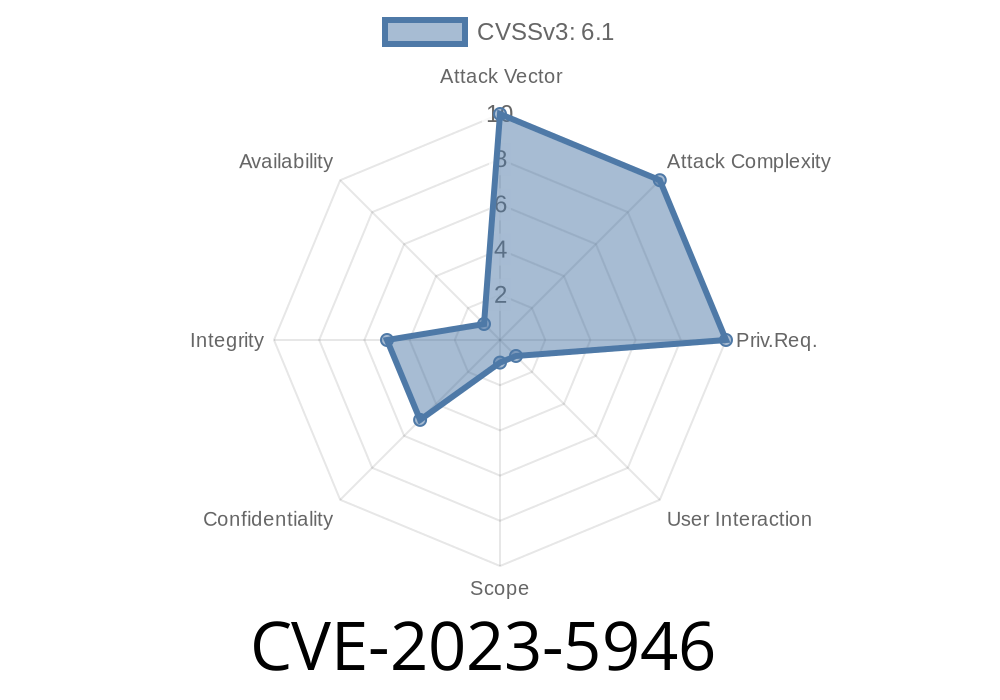WordPress, the world's most popular content management system, is trusted by millions of users worldwide. However, its wide adoption also makes it an attractive target for cyber attackers. One such vulnerability has been discovered in the Digirisk plugin for WordPress, which millions of users rely on for risk assessment and management. Researchers have found that the plugin is vulnerable to Reflected Cross-Site Scripting (XSS) in version 6... due to insufficient input sanitization and output escaping. This vulnerability, identified as CVE-2023-5946, could allow unauthenticated attackers to inject malicious web scripts into pages that execute when a user clicks on a compromised link. This post will discuss the details of this vulnerability, provide code snippets to understand its implications, and offer recommendations for securing your WordPress site against this exploit.
Vulnerability Details
The Digirisk plugin for WordPress, specifically version 6..., is vulnerable to Reflected XSS due to inadequate input sanitization and output escaping of the 'current_group_id' parameter. This vulnerability results from the fact that the plugin fails to properly sanitize and escape user-supplied data.
When an attacker injects malicious web scripts into pages with this vulnerability, they can potentially gain access to sensitive information such as login credentials, manipulate site content, or redirect users to other malicious websites.
Code Snippet
Below is an example of the vulnerable code in the Digirisk plugin for WordPress, where the 'current_group_id' parameter is not properly sanitized and escaped:
$current_group_id = $_GET['current_group_id'];
echo "Current Group ID: " . $current_group_id;
Using this vulnerable code, an attacker can craft a malicious URL by injecting a script payload as the 'current_group_id' parameter:
https://example.com/path?current_group_id=<script>alert('XSS')</script>;
When a user clicks on this link, the malicious script will execute in their browser, potentially leading to sensitive data exposure or unwanted actions on the website.
Original Reference Links
This vulnerability was discovered by security researchers who responsibly disclosed the issue through a public advisory. More information regarding this vulnerability, along with mitigation steps, can be found at the following links:
- CVE-2023-5946 (MITRE)
- WPScan Vulnerability Database (WPScan)
Exploit Details and Mitigation
To exploit this vulnerability, attackers do not require any authentication, and simply need to trick a user into clicking on a malicious link. This can often be achieved through social engineering techniques, such as sending phishing emails or posting links on forums and social media platforms.
As a WordPress site owner or administrator, you can take the following steps to secure your site against this vulnerability:
Update your Digirisk plugin to the latest version, which fixes this vulnerability.
2. Implement input sanitization and output escaping for all user-supplied data on your site to ensure that potentially malicious content cannot be executed.
3. Train your users to identify phishing emails and other social engineering attacks to reduce the risk of attackers tricking them into clicking malicious links.
Conclusion
The CVE-2023-5946 vulnerability in the Digirisk plugin for WordPress 6... represents a significant risk to WordPress sites worldwide. By understanding this vulnerability and taking steps to mitigate its impact, you can help protect your site, its users, and its sensitive data from attackers seeking to exploit this weakness.
Timeline
Published on: 11/03/2023 14:15:08 UTC
Last modified on: 11/13/2023 17:43:39 UTC
